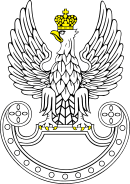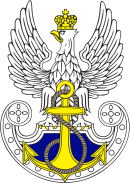January Uprising
| January Uprising | |||||||
|---|---|---|---|---|---|---|---|
"Polonia (Poland), 1863", by Jan Matejko, 1864, oil on canvas, 156 × 232 cm, National Museum, Kraków. Pictured is the aftermath of the failed January 1863 Uprising. Captives await transportation to Siberia. Russian officers and soldiers supervise a blacksmith placing shackles on a woman (Polonia). The blonde girl next to her represents Lithuania. | |||||||
| |||||||
| Belligerents | |||||||
|
and multicultural insurgents |
| ||||||
| Strength | |||||||
| around 200,000 over the course of the uprising | unknown | ||||||
| Casualties and losses | |||||||
| 10,000 to 20,000 | |||||||
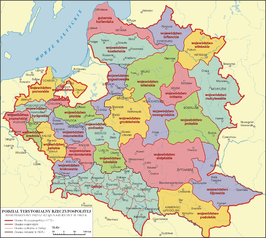
The January Uprising (Polish: powstanie styczniowe, Lithuanian: 1863 m. sukilimas, Belarusian: Паўстанне 1863-1864 гадоў) was an uprising in the former Polish-Lithuanian Commonwealth (present-day Poland, Lithuania, Belarus, Latvia, parts of Ukraine, and western Russia) against the Russian Empire. It began on 22 January 1863 and lasted until the last insurgents were captured in 1864.
The uprising began as a spontaneous protest by young Poles against conscription into the Imperial Russian Army. It was soon joined by high-ranking Polish-Lithuanian officers and various politicians. The insurrectionists, severely outnumbered and lacking serious outside support, were forced to resort to guerrilla warfare tactics.
Public executions and deportations to Siberia led many Poles to abandon armed struggle and turn instead to the idea of "organic work": economic and cultural self-improvement.
Eve of the uprising
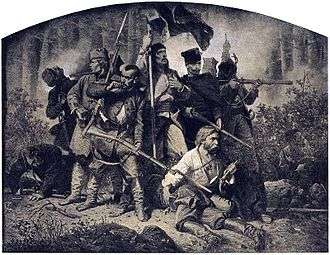
After the Russian Empire lost the Crimean war and was weakened economically and politically, unrest started in the former Polish-Lithuanian Commonwealth. In Vilna alone 116 demonstrations were held in 1861. In August 1861, protests in Vilna ended in clashes with the Imperial Russian Army. In spite of Russian police and Cossack interference, a symbolic meeting of hymn-singing Poles and Lithuanians took place on the bridge across the Niemen River. Another mass gathering took place in Horodło, where the Union of Horodło had been signed in 1413. The crowds sang Boże, coś Polskę (God protect Poland) in Lithuanian and Belarusian. In the autumn of 1861 Russians had introduced a state of emergency in Vilna Governorate, Kovno Governorate and Grodno Governorate.[1]
After a series of patriotic riots, the Russian Namestnik (regent) of Tsar Alexander II, General Karl Lambert, introduced martial law in Poland on 14 October 1861. Public gatherings were banned and some public leaders were declared outlaws.
The future leaders of the uprising gathered secretly in St. Petersburg, Warsaw, Vilna, Paris and London. After this series of meetings two major factions emerged. The Reds represented united peasants, workers, and some clergy, while The Whites represented liberal minded landlords and intelligentsia of the time. In 1862 two initiative groups were formed for the two components of the former Polish-Lithuanian Commonwealth.
Uprising in the former Polish-Lithuanian Commonwealth
The uprising broke out at a moment when general quiet prevailed in Europe, and though there was a public outcry in support of the Poles, powers such as France, Britain and Austria were unwilling to disturb the calm. The potential revolutionary leaders did not have sufficient means to arm and equip the groups of young men who were hiding in forests to escape Alexander Wielopolski's order of conscription into the Russian army. Altogether about 10,000 men rallied around the revolutionary banner; they were recruited chiefly from the ranks of the city working classes and minor clerks, although there was also a considerable admixture of the younger sons of the poor szlachta and a number of priests of lower rank.
To deal with these ill-armed units the Russian government had at its disposal an army of 90,000 men under General Ramsay in Poland. It looked as if the rebellion would be crushed quickly. The die was cast, however, the provisional government applied itself to this great task with fervor. It issued a manifesto in which it pronounced "all sons of Poland are free and equal citizens without distinction of creed, condition and rank." It declared that land cultivated by the peasants, whether on the basis of rent or service, henceforth should become their unconditional property, and compensation for it would be given to the landlords out of the general funds of the State. The revolutionary government did its very best to supply with provisions the unarmed and scattered guerrillas who, during the month of February, met the Russians in eighty bloody encounters. Meanwhile, it issued an appeal to the nations of western Europe, which was received everywhere with a genuine and heartfelt response, from Norway to Portugal. Pope Pius IX ordered a special prayer for the success of the Catholic Polish in their defence against the Orthodox Russians, and was very active in arousing sympathy for the Polish rebels.
Uprising in the former Grand Duchy of Lithuania

In Lithuania, Belarus, Latvia, northern Ukraine and western Russia the uprising started on February 1, 1863. A coalition government of the Reds and the Whites was formed. It was led by Zygmunt Sierakowski, Antanas Mackevičius and Konstanty Kalinowski. They fully supported their counterparts in Poland and adhered to the same policy.
Polish, Lithuanian and Belarusian insurgents were more numerous (up to 30,000 men at the peak of uprising) and a little better armed, but there were 135,000 Russian troops and 6,000 Cossacks in Lithuania and another 45,000 Russian troops in Volhynia. In every major military engagement of the uprising insurgents were outnumbered at least 10 to 1.
Insurgents of szlachta background constituted 60% percent of the uprising's participants (in Lithuania and Belarus around 50%, in Ukraine some 75%).[2] The percentage of Catholics among the insurgents in Lithuania was 95%[3] The insurgence was not supported by the majority of the Orthodox Belarusian peasantry who considered the Catholics to be their historical oppressors.[4]
During the first 24 hours of the uprising armories across the country were looted, many Russian officials executed on sight. 2 February 1863 saw the start of the first major military engagement of the uprising between Lithuanian peasants (mostly armed with scythes) and a squadron of Russian hussars near Čysta Būda, near Marijampolė. It ended with a massacre of the unprepared peasants. As hope of a short war was present, insurgent groups merged into bigger formations and recruited new personnel.
On 7 April Zygmunt Sierakowski, who was able to recruit and arm 2500 men for the cause, was elected to be the military commander in chief of the reborn PLC. Under his command the peasant army was able to achieve several difficult victories near Raguva on 21 April, Biržai on 2 May, Medeikiai on 7 May. However, tired from a several week long marches and combat, the insurgent army suffered a defeat on 8 May near Gudiškis.
Evolution of events

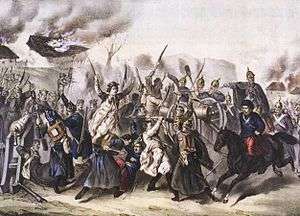
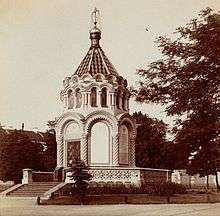
The provisional government counted on a revolutionary outbreak in Russia, where the discontent with the autocratic regime seemed at the time to be widely prevalent. It also counted on the active support of Napoleon III, particularly after Prussia, foreseeing an inevitable armed conflict with France, made friendly overtures to Russia in the Alvensleben Convention and offered assistance in suppressing the Polish uprising. On the 14th day of February arrangements had already been completed, and the British Ambassador in Berlin was able to inform his government that a Prussian military envoy "has concluded a military convention with the Russian Government, according to which the two governments will reciprocally afford facilities to each other for the suppression of the insurrectionary movements which have lately taken place in Poland and Lithuania. The Prussian railways are also to be placed at the disposal of the Russian military authorities for the transportation of troops through Prussian territory from one part of the former Polish-Lithuanian commonwealth to another." This step of Bismarck led to protests on the part of several governments and roused the nations of the Commonwealth. The result was the transformation of the insignificant uprising into another national war against Russia. Encouraged by the promises made by Napoleon III, all nations, acting upon the advice of Władysław Czartoryski, the son of Prince Adam, took to arms. Indicating their solidarity, all Commonwealth citizens holding office under the Russian Government, including the Archbishop of Warsaw, resigned their positions and submitted to the newly constituted Government, which was composed of the five most prominent representatives of the Whites.
Apart from the efforts of Sweden, diplomatic intervention of foreign powers on behalf of Poland did more harm than good due to drawing focus on Polish national unity versus social inequality. It alienated Austria, which hitherto had maintained a friendly neutrality with reference to Poland and had not interfered with Polish activities in Galicia. It prejudiced public opinion among the radical groups in Russia who, until that time, had been friendly because they regarded the uprising as of a social rather than a national character and it stirred the Russian Government to more energetic endeavors toward the speedy suppression of hostilities which were growing in strength and determination.
In addition to the thousands who fell in battle, 128 men were hanged personally by Mikhail Muravyov ('Muravyov the Hangman'), and 9,423 men and women were exiled to Siberia (2,500 men according to low Russian data estimates, Norman Davies gives the number of 80,000 noting it was the single largest deportation in Russian history).[5] Whole villages and towns were burned down; all activities were suspended and the szlachta was ruined by confiscation and exorbitant taxes. Such was the brutality of the Russian troops that their actions were condemned throughout Europe, and even in Russia itself Muravyov became ostracized.[6] Count Fyodor Berg, the newly appointed Namestnik of Poland, followed in Muravyov's footsteps, employing inhumanly harsh measures against the country.
The Reds criticized the Polish National Government for being reactionary in its policy to provide incentive to Polish peasants to fight in the uprising. The Government defended its inaction with hopes of foreign military aid promised by Napoleon III. It was only after Polish general Romuald Traugutt took matters in his own hands to unite the classes under a national cause that the situation became brighter. On 27 December 1863 he enacted the decree of the former provisional government by granting peasants the land they worked on. This land was to be provided by compensating the owners through state funds at the successful conclusion of the uprising. Traugutt called upon all Polish classes to rise against Russian oppression for the creation of the new Polish state. The response was generous but not universal since the policy was adopted too late. The Russian Government had already been working among the peasants giving liberal parcels of land for the mere asking. The peasants that were bought off did not interfere with the Polish revolutionaries to any great extent but they also did not provide support. Fighting continued intermittently for several months. Among the generals, Count Józef Hauke-Bosak distinguished himself most as a commander of the revolutionary forces and took several cities from the vastly superior Russian army. When Traugutt and the four other members of the Polish Government were apprehended by Russian troops and executed at the Warsaw citadel, the war in the course of which 650 battles and skirmishes were fought and twenty-five thousand Polish killed, came to a speedy end in the latter half of 1864, having lasted for eighteen months. It is of interest to note that it persisted in Samogitia and Podlaskie, where the Greek-Catholic population, outraged and persecuted for their religious convictions, clung longest to the revolutionary banner.
The uprising was finally crushed by Russia in 1864.
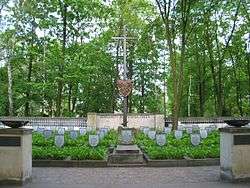
After the collapse of the uprising, harsh reprisals followed. According to Russian official information, 396 persons were executed and 18,672 were exiled to Siberia. Large numbers of men and women were sent to the interior of Russia and to Caucasus, Urals and other sections. Altogether about 70,000 persons were imprisoned and subsequently taken out of Poland and stationed in remote regions of Russia.
The government confiscated 1,660 estates in Poland and 1,794 in Lithuania. A 10% income tax was imposed on all estates as a war indemnity. Only in 1869 was this tax reduced to 5% on all incomes. Serfdom was abolished in Russian Poland on 19 February 1864. It was deliberately enacted in a way that would ruin the szlachta. It was the only area where peasants paid the market price in redemption for the land (the average for the empire was 34% above the market price). All land taken from Polish peasants since 1846 was to be returned without redemption payments. The ex-serfs could only sell land to other peasants, not szlachta. 90% of the ex-serfs in the empire who actually gained land after 1861 were in the 8 western provinces. Along with Romania, Polish landless or domestic serfs were the only ones to be given land after serfdom was abolished.
All this was to punish the szlachta's role in the uprisings of 1830 and 1863. Besides the land granted to the peasants, the Russian Government gave them additional forest, pasture and other privileges (known under the name of servitutes) which proved to be a source of incessant irritation between the landowners and peasants in the following decades, and an impediment to economic development. The government took over all the church estates and funds, and abolished monasteries and convents. With the exception of religious instruction, all other studies in the schools were ordered to be in the Russian. Russian also became the official language of the country, used exclusively in all offices of the general and local government. All traces of former Polish autonomy were removed and the kingdom was divided into ten provinces, each with an appointed Russian military governor and all under complete control of the Governor-General at Warsaw. All former Polish government functionaries were deprived of their positions and replaced by Russian officials.
According to George Kennan, "thousands of Polish insurgents" were transported to the "Nerchinsk silver-mining district...after the unsuccessful insurrection of 1863."[7]
This measures proved to be of limited success. In 1905, 41 years after Russian crushing of the uprising, the next generation of Poles rose once again in a new one.
Famous insurgents
- Francišak Bahuševič (1840–1900), Belarusian poet and writer, one of the founders of modern Belarusian literature
- Stanisław Brzóska (1832–1865), was a Polish priest and commander at the end of the insurrection.
- Saint Albert Chmielowski (1845–1916), founder of the Albertine Brothers and Sisters.
- Konstanty Kalinowski (1838–1864), was one of the leaders of Lithuanian and Belarusian national revival and the leader of the January Uprising in the lands of the former Grand Duchy of Lithuania.
- Saint Raphael Kalinowski (1835–1907), born Joseph Kalinowski in Lithuania, resigned as a Captain from the Russian Army to become Minister of War for the Polish insurgents. He was arrested and sentenced to death by firing squad, but the sentence was then changed to 10 years in Siberia, including a grueling nine-month overland trek to get there.
- Apollo Korzeniowski (1820–1869), Polish playwright and father of Joseph Conrad.
- Antanas Mackevičius (1828–1863), Lithuanian priest who organized some two hundred and fifty men, armed with hunting rifles and straightened scythes. After a defeat near Vilkija, he was captured and taken to the prison in Kaunas. After Mackevičius refused to betray other leaders of the uprising, he was hanged on December 28, 1863,
- Władysław Niegolewski (1819–1885), was a liberal Polish politician and member of parliament, an insurgent in the Greater Poland Uprisings of 1846 and 1848 and of the January 1863 Uprising, and a co-founder (1861) of the Central Economic Society (TCL) and (1880) the People's Libraries Society (CTG).
- Bolesław Prus, (1847–1912), Polish writer.
- Aleksander Sochaczewski (1843–1923), Polish painter.
- Aleksander Waszkowski (1841–1865), President of Polish National Government (Leader of the January Insurrection. Arrested Dec 1864, Executed 1865.
In literature
- Polish poet Cyprian Norwid wrote a famous poem, "Chopin's Piano," describing the defenestration of the composer's piano during the January 1863 Uprising, when Russian soldiers maliciously threw the instrument out of a second-floor Warsaw apartment. Chopin had left Warsaw and Poland forever shortly before the outbreak of the November 1830 Uprising.
- In the initial draft of Twenty Thousand Leagues Under the Sea by Jules Verne (but not in the published version), Captain Nemo was a Polish nobleman whose family had been brutally murdered by the Russians during the January 1863 Uprising. Since France had only recently signed an alliance with Tsarist Russia, in the novel's final version Verne's editor, Pierre-Jules Hetzel, made him obscure Nemo's motives.
- In Guy de Maupassant's novel Pierre et Jean, the protagonist Pierre has a friend, an old Polish chemist that is said to come to France after the bloody events in his motherland. This story is believed to refer to the January Uprising.
See also
References
This article incorporates text from The political history of Poland (1917) by Edward Henry Lewinski Corwin, a publication now in the public domain.
- ↑ Piotr S. Wandycz, The lands of partitioned Poland, 1795-1918, University of Washington Press, 1974, p. 166.
- ↑ Sikorska-Kulesza, Jolanta (1995). Deklasacja drobnej szlachty na Litwie i Białorusi w XIX wieku. Pruszków, PL: Ajaks. p. 29. ISBN 9788385621379.
- ↑ Зайцев, В. М (1973). Социально-сословный состав участников восстания 1863 г. (Опыт статистического анализа) [Social-estates composition of the participants in the uprising in 1863 (attempt at statistical analysis)] (in Russian). Москва: Наука.
- ↑ Историк: 'В 1863 году белорусы поддержали не Польшу и Калиновского, а Россию и государя' [Historian: 'In 1863, Belarusians did not support Poland and Kalinowski, but Russia and its sovereign']. regnum.by (in Russian). 2013-01-23. Archived from the original on 2013-09-27.
- ↑ Norman Davies (1996). Europe: a history. Oxford University Press. pp. 828–. ISBN 978-0-19-820171-7. Retrieved 2 February 2011.
- ↑ Adam Bruno Ulam (1977). Prophets and conspirators in prerevolutionary Russia. Transaction Publishers. pp. 8–. ISBN 978-0-7658-0443-3. Retrieved 2 February 2011.
- ↑ Kennan, George (1891). Siberia and the Exile System. London: James R. Osgood, McIlvaine & Co. p. 280.
External links
| Polish Wikisource has original text related to this article: |
- Database of January insurgents
- Augustin O'Brien Petersburg and Warsaw: scenes witnessed during a residence in Poland and Russia in 1863-1864 (1864)
- William Ansell Day. The Russian government in Poland : with a narrative of the Polish Insurrection of 1863 (1867)
- Pictures and paintings dedicated January Uprising on Youtube
- Szwadron (1992) Polish movie about the uprising
